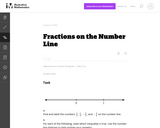
This task requires students to place fractions onto a number line.
- Subject:
- Mathematics
- Material Type:
- Activity/Lab
- Provider:
- Illustrative Mathematics
- Provider Set:
- Illustrative Mathematics
- Author:
- Illustrative Mathematics
- Date Added:
- 08/09/2012

This task requires students to place fractions onto a number line.

Urban governance comprises the various forces, institutions, and movements that guide economic and physical development, the distribution of resources, social interactions, and other aspects of daily life in urban areas. This course examines governance from legal, political, social, and economic perspectives. In addition, we will discuss how these structures constrain collective decision making about particular urban issues (immigration, educationŰ_). Assignments will be nightly readings and a short paper relating an urban issue to the frameworks outlined in the class.

This task involving amusement park games requires students to calculate probability.

Spreadsheets Across the Curriculum module. Students examine the number of large earthquakes (magnitude 7 and above) per year for 1970-1999 and 1940-1999. QL: descriptors of a frequency distribution.

This series of 5 word problems lead up to the final problem. Most students should be able to answer the first two questions without too much difficulty. The decimal numbers may cause some students trouble, but if they make a drawing of the road that the girls are riding on, and their positions at the different times, it may help. The third question has a bit of a challenge in that students won't land on the exact meeting time by making a table with distance values every hour. The fourth question addresses a useful concept for problems involving objects moving at different speeds which may be new to sixth grade students.

This taks is word problem requires students to calculate distance and speed.

Instructions for conducting an experiment using a growing system made from plastic soda bottles to find out what effect salt has on Fast Plants.

The problem requires students to not only convert miles to kilometers and gallons to liters but they also have to deal with the added complication of finding the reciprocal at some point. In the USA we use distance per unit volume to measure fuel efficiency but in Europe we use volume per unit distance. Furthermore, the unit of distance is not simply 1 km but rather 100 km.

In this activity, students investigate the simulated use of solid rocket fuel by using an antacid tablet. Students observe the effect that surface area and temperature has on chemical reactions. Also, students compare the reaction time using two different reactants: water and vinegar. Finally, students report their results using a bar graph.
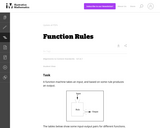
This task can be played as a game where students have to guess the rule and the instructor gives more and more input output pairs. Giving only three input output pairs might not be enough to clarify the rule.
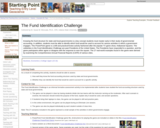
Knowing the fund structure for state and local governments is a key concept students must master early in their study of governmental accounting. In addition, students must be able to identify which fund would be used to account for various activities in which a government engages. This PowerPoint game is a drill and practice/review activity fashioned after the popular TV game show, Hollywood Squares. The celebrities in the Fund Identification Challenge are past Presidents of the United States. The Presidents have responded to a question, and the game participants either agree or disagree with the response to earn the square. The 27 real-world examples found in the game were derived by examining the Comprehensive Annual Financial Reports (CAFR) of various cities.

This task requires students to think about and compare fractions.

While we know air exists around us all the time, we usually do not notice the air pressure. During this activity, students use Bernoulli's principle to manipulate air pressure so its influence can be seen on the objects around us.

In this five lesson unit with overview from Illuminations, student activities explore relationships among fractions through work with the length model. Students construct fraction strips and use fraction bars throughout the unit to make sense of basic fraction concepts, to compare fractions and order fractions and to work with equivalency in fractions. Specific learning objectives, a material list, an instructional plan, questions for the students, assessment options, extensions, and teacher reflections are given for each lesson.

This unit from Illuminations consists of five lessons designed to help students understand fractions when they are represented as a part of a region. Learners investigate relationships between parts and wholes, the relative value of the fraction based on the pattern block shape and equivalency while working with physical and/or virtual pattern blocks. Instructional plan, questions for the students, assessment options, extensions, and teacher reflections are given for each lesson.
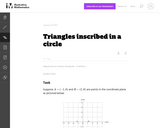
The goal of this task is to use ideas about linear functions in order to determine when certain angles are right angles. The key piece of knowledge implemented is that two lines (which are not vertical or horizontal) are perpendicular when their slopes are inverse reciprocals of one another.
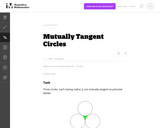
This is a task from the Illustrative Mathematics website that is one part of a complete illustration of the standard to which it is aligned. Each task has at least one solution and some commentary that addresses important asects of the task and its potential use. Here are the first few lines of the commentary for this task: Three circles, each having radius 2, are mutually tangent as pictured below: What is the total area of the circles together with the shaded region?...
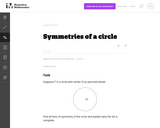
This is a task from the Illustrative Mathematics website that is one part of a complete illustration of the standard to which it is aligned. Each task has at least one solution and some commentary that addresses important asects of the task and its potential use. Here are the first few lines of the commentary for this task: Suppose $C$ is a circle with center $O$ as pictured below: Find all lines of symmetry of the circle and explain why the list is complete....

This is a task from the Illustrative Mathematics website that is one part of a complete illustration of the standard to which it is aligned. Each task has at least one solution and some commentary that addresses important asects of the task and its potential use. Here are the first few lines of the commentary for this task: Choose two distinct points $A$ and $B$ in the plane. For which points $C$ is $\triangle ABC$ a right triangle? For which points $C$ is $\triangle ABC$ ...
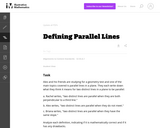
This is a task from the Illustrative Mathematics website that is one part of a complete illustration of the standard to which it is aligned. Each task has at least one solution and some commentary that addresses important asects of the task and its potential use. Here are the first few lines of the commentary for this task: Alex and his friends are studying for a geometry test and one of the main topics covered is parallel lines. They each write down what they think it mea...